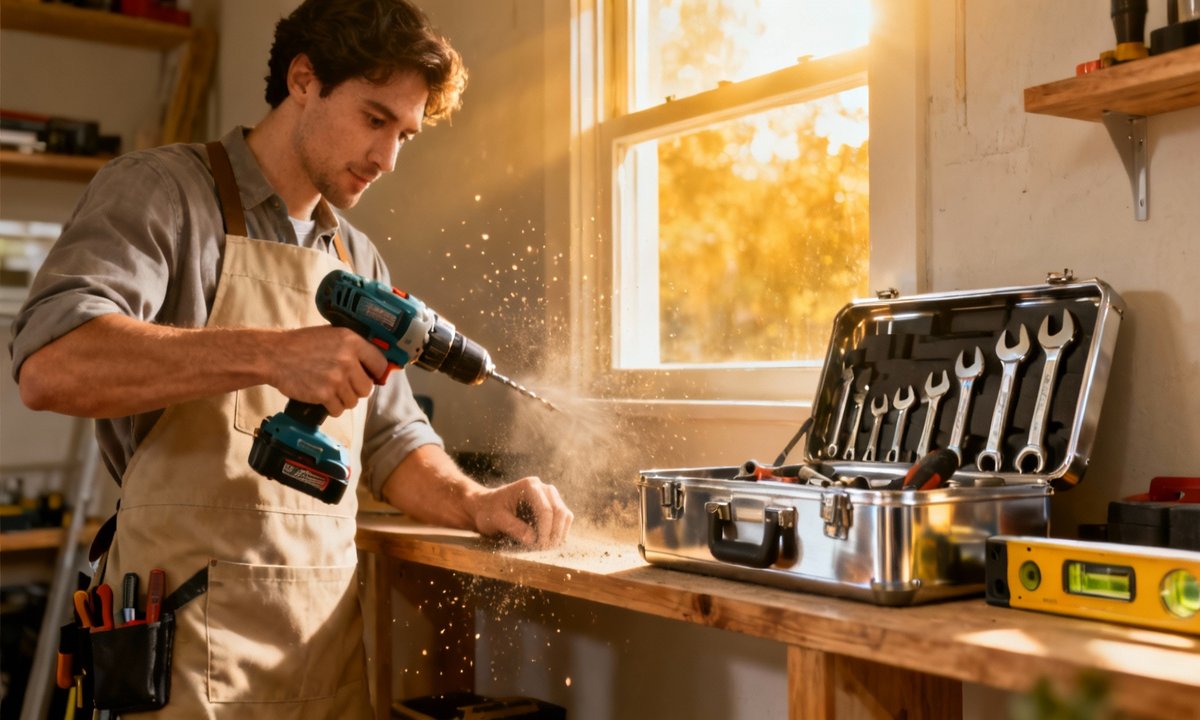Keeping your home in top shape doesn’t always demand endless bills from handymen or contractors. With the right tools and practical knowledge, you can master essential DIY home repair hacks and confidently handle everyday maintenance tasks. This guide offers essential tools, top skills, and must-know tips to enhance your home’s functionality and beauty, all while significantly cutting down on repair expenses.
Why DIY Home Repair Empowers Homeowners
As home maintenance costs continue to climb, many homeowners are discovering the advantages of tackling minor repairs themselves. Developing your toolkit and acquiring a few fundamental skills can empower you to fix issues promptly, prevent more costly problems, and effectively maintain your property’s value. The significant benefit is gaining greater control and independence over your home projects. To keep everything organized and ready, exploring tips for organizing your tools effectively can be very helpful.
Essential Home Repair Tools Every Homeowner Should Have
Before diving into home repair hacks, it’s wise to gather these indispensable tools. This foundational collection is designed to manage most common repair scenarios you might encounter around the house. These selections ensure you are prepared for a wide array of projects, making your efforts both efficient and successful.
- Tape Measure: Opt for a 25-foot tape with a comfortable grip for accurate measurements every time.
- Screwdriver Set: A versatile set including both flathead and Phillips, or a multi-bit kit, offers maximum flexibility.
- Hammer (Claw Type): A 16-ounce hammer, with a steel or fiberglass handle, is ideal for driving and safely removing nails.
- Adjustable Wrench: This tool makes loosening or tightening bolts and various plumbing fixtures incredibly easy.
- Pliers: A basic set featuring needle-nose and slip-joint styles will cover a wide range of gripping needs.
- Utility Knife: Indispensable for cutting drywall and opening packages, ensure it has easily replaceable blades.
- Level: A torpedo level is perfect for ensuring that shelves, pictures, and frames are always perfectly straight.
- Flashlight: A reliable headlamp or a battery-powered LED lamp is crucial for working in dimly lit areas or during power outages.
- Handsaw: This tool is handy for small-scale projects involving wood, PVC, or light metal components.
For efficient and quick access to all your tools, learning more about essential home organization can help you create a highly functional toolkit. This approach ensures you always have the right tool at your fingertips, saving time and frustration during projects.
Go Electric: Power Tools That Revolutionize Repairs
Integrating power tools into your repair routine can significantly enhance efficiency and transform your overall home improvement experience. These three selections are considered vital for anyone serious about tackling more involved DIY home projects. They provide the power and precision needed for a variety of tasks, making complex jobs more manageable.
- Cordless Drill: This highly versatile tool excels at drilling, driving screws, and can even be used for sanding with specific attachments.
- Jigsaw: Offering safer and more precise cuts, a jigsaw is excellent for creative and intricate projects.
- Circular Saw: Not exclusively for professionals, this saw is invaluable for making straight, clean cuts in various materials like wood or plastic.
- Sander: Electric sanders simplify the preparation of walls and furniture, making tasks like smoothing surfaces much quicker and easier.
Equipped with these powerful tools, you will be well-prepared for a broad spectrum of projects, from straightforward drywall patching to more intricate budget-friendly DIY decor upgrades throughout your home. They truly expand your capabilities.
Top 15 DIY Home Repair Hacks for Common Issues
Discover these tried-and-tested DIY home repair hacks, valued by both beginners and experienced enthusiasts, for their ability to save money and alleviate stress. These solutions address everyday problems with simple, effective methods, making home maintenance accessible to everyone. Each tip provides a practical way to keep your home functioning smoothly.
1. Quick Fix for Stuck Doors
If a door isn’t closing smoothly, start by tightening its hinge screws. Should the door stick near the latch, simply rub a bar of soap or candle wax along the problematic edge. A few quick applications will help your door glide effortlessly once more, solving a common household annoyance.
2. Silence Squeaky Floors
To quiet annoying squeaky floorboards, gently sprinkle baby powder or powdered graphite into the seams where they rub together. Sweep the powder deeply into the cracks; this simple action often quiets the squeak almost instantly, bringing peace back to your home.
3. Patch Small Holes in Drywall
For small drywall holes, apply a lightweight spackle with a putty knife, smoothing it flat over the opening. Once dry, gently sand the area before repainting to achieve a flawless finish. This method ensures seamless repairs without professional help.
4. Fix a Leaky Faucet with a Wrench and Washer
To repair a dripping faucet, first, turn off the water supply and remove the faucet handle. A simple replacement of the washer can resolve most leaks in under 15 minutes. This skill is fundamental for basic plumbing repair DIY, saving you time and money.
5. Unclog Drains Using Baking Soda and Vinegar
An eco-friendly way to unclog slow drains involves pouring half a cup of baking soda, followed by half a cup of vinegar. Allow it to sit for ten minutes, then flush with hot water. This beginner-friendly tip helps avoid harsh chemicals and saves on costly drain products.
6. Repair Loose Cabinet Hinges
If cabinet screws no longer hold firmly, insert wooden toothpicks with wood glue into the screw holes. Break the toothpicks flush with the surface, let them dry completely, then reinsert the screws for a secure and lasting fit. This provides a simple and effective solution.
7. Remove Stripped Screws with a Rubber Band
For a stripped screw, place a wide rubber band between the screw head and your screwdriver. This technique significantly improves grip, helping you extract stubborn screws without requiring specialized tools. It’s a remarkably simple yet effective hack for tricky situations.
8. Refresh Grout with a Whitening Pen
Revitalize dingy grout lines in your kitchen or bathroom by using a whitening pen. First, clean the grout thoroughly, then draw over the lines for a crisp, like-new appearance. This quick update makes a noticeable difference.
9. Stop Drafts Fast
Effectively seal drafty doors and windows using adhesive weather-stripping. This simple home repair hack not only saves money on your energy bills but also significantly improves your home’s overall comfort. For additional savings, explore smart home upgrades for energy efficiency.
10. Quiet a Banging Cabinet Door
To prevent cabinet doors from slamming, simply stick a self-adhesive bumper pad inside the cabinet frame. This small addition softens impacts, significantly prolongs hinge life, and reduces noise, creating a quieter home environment.
11. Paint Touch-Up Like a Pro
Keep small, sealed containers of leftover paint, clearly marked with the room and paint code, along with a touch-up brush. This ensures quick, seamless fixes for any scuffs or marks that appear, maintaining your home’s pristine look effortlessly.
12. Fix a Running Toilet
A persistently running toilet often needs a new flapper. Simply turn off the water, flush the toilet, replace the old flapper, and reconnect the water. This straightforward DIY repair is a cost-saving win, eliminating leaks and conserving water.
13. Replace Broken Tiles
Carefully chisel out the damaged tile, scrape away any old adhesive, and then set a new tile with fresh mortar. After 24 hours, apply grout. This process eliminates the need for a professional tile installer, saving on labor costs.
14. Patch Carpet Snags
For carpet snags, carefully trim a small fiber from an inconspicuous area. Glue it precisely into the snagged spot, then gently brush to blend it in. This technique helps high-traffic areas maintain their best appearance without extensive repairs.
15. Unstick Stubborn Locks
If a lock is stubborn, apply powdered graphite—never oil—to the keyhole. Insert and rotate the key several times to distribute the graphite, which lubricates the tumblers and helps free up sticky mechanisms. This simple trick can restore smooth operation.
Money-Saving DIY Techniques by Room
Let’s explore valuable home repair hacks tailored specifically for the most frequently used areas in your home. Understanding these targeted solutions can help you prioritize where to start for the greatest impact and most efficient savings. Each room offers unique opportunities for effective DIY projects.
Kitchen DIY Repair Hacks
Adjusting stubborn cabinet doors can be done easily with a screwdriver; simply tighten or loosen hinges until they align perfectly. Replacing a leaky sink sprayer is as simple as unscrewing the old one and attaching a new head, using plumber’s tape for a watertight seal. Consider installing peel-and-stick backsplash tiles for an instant refresh that requires no special tools. For those aiming to blend repairs with aesthetic upgrades, our guide to budget-friendly DIY decor ideas for every room offers comprehensive inspiration.
Bathroom DIY Solutions
Stop a persistent tub drip by replacing worn-out washers, a quick and easy fix. Renew caulk lines around tubs and sinks by carefully scraping away the old caulk and applying a fresh bead for a clean finish. Install a water-saving showerhead using pliers and plumber’s tape, achieving both a maintenance update and an efficiency upgrade.
Living Room & Bedroom Fixes
Firmly tighten wobbly furniture legs using your screwdriver set to restore stability. Patch small wall holes seamlessly with spackle and a putty knife for a smooth surface. Touch up minor floor scratches with furniture markers or blending crayons, making them virtually disappear.
Electrical Repairs You Can Handle
When replacing an old outlet, always shut off power at the breaker and use a voltage tester to confirm safety before proceeding to swap it out. Make sure to carefully follow instructions for your specific wiring. Installing new light fixtures involves connecting matching wires, always ensuring the power is off first for safety. Consider upgrading to smart switches for automation and energy savings, an accessible enhancement for any home.
Plumbing Fixes for Beginners
To unclog a sink, use a plunger or create a homemade snake from an unraveled wire hanger for quick blockages. Changing your toilet flapper or fill valve is an effective way to stop leaks and reduce water waste. You can fix most faucet drips in minutes by replacing kitchen faucet cartridges with an adjustable wrench.
Drywall Patching and Touch-ups
Effortlessly fill nail holes by dabbing a small amount of spackle with your finger. Allow it to dry, then lightly sand for flawlessly smooth walls. For medium-sized holes, a wall patch kit with adhesive mesh, followed by spackle, sanding, and paint, works wonders. Always sand between coats to achieve truly smooth, professional-level results.
Door and Window Maintenance
Lubricate window tracks with silicone spray to ensure they open and close smoothly throughout the year. Tighten or replace door weatherstripping to effectively block drafts and enhance energy efficiency. Adding insulation to attic doors can also greatly improve climate control, helping maintain consistent indoor temperatures year-round.
Basic Skills Every Homeowner Should Master
Knowing which skills to practice is often as important as the tools you possess for effective home maintenance. Mastering these essential abilities will empower you to tackle a broader range of projects with confidence and efficiency. They form the foundation for many successful DIY endeavors.
Hanging and Mounting
Always use a stud finder to locate wall studs for secure TV mounting or installing heavy shelves. Mark the exact location, ensure your mount is level, and drill pilot holes before inserting screws. For more creative enhancements, consider various DIY home improvement projects to personalize your space.
Basic Plumbing Repairs
Tackling drips and leaks means understanding washers, supply lines, and mastering the use of an adjustable wrench. Practice identifying shut-off valves and approach leaks with patience and a systematic approach. This foundation helps prevent minor issues from becoming major problems.
Paint Touch-Ups and Drywall Repair
Learn to caulk neatly, spot prime effectively, and apply touch-up paint that perfectly matches your wall’s finish for invisible repairs. This skill ensures that your walls maintain a pristine appearance, effortlessly concealing any imperfections.
Electrical Safety & Swaps
Become comfortable with safely swapping out switch plates, installing dimmer switches, and replacing LED bulbs. Always know the location of your home’s breaker box and consistently use a voltage tester to confirm power is off before starting any electrical repairs.
Furniture Assembly & Repair
Assembling flat-pack furniture becomes much easier with the correct screwdriver and Allen wrenches. Practice patience and carefully follow diagrams to achieve flawless builds every time. Reviewing furniture assembly tips can further streamline your process and prevent common mistakes.
When to DIY vs. When to Call a Professional
While it’s rewarding to fix things yourself, it’s equally important to recognize when professional help is essential. For major electrical, gas, or structural repairs, always contact a licensed professional to ensure safety and compliance. However, for minor home repairs and cosmetic upgrades, DIY is often a quicker and far more economical option.
Carefully compare the cost and time commitment involved for each task. If a project requires special permits or highly specialized skills, avoid risking safety or potential code violations. For sustained financial benefits, exploring frugal living hacks that can save you thousands can further enhance your economic independence.
Safety Tips for DIY Home Repairs
DIY projects offer significant savings, but never at the expense of your health and well-being. Always adhere to these fundamental safety principles to ensure every repair is completed securely and without incident. Prioritizing safety is paramount in any home improvement endeavor.
- Always wear safety goggles and gloves when engaging in cutting, sanding, or drilling activities to protect yourself.
- Never attempt repairs on live electrical circuits; it is crucial to test wires with a voltage tester first to confirm power is off.
- Always use a sturdy ladder instead of unsteady furniture, and avoid overreaching when painting or changing high light bulbs.
- Store tools securely away from children and pets; for more on this, consult essential home organization tips.
Building Your DIY Toolkit on a Budget
You don’t need to spend a fortune to assemble a robust DIY toolkit. Begin by acquiring the fundamental tools, and then gradually add more specialized items as specific projects arise. This approach allows you to build a comprehensive kit efficiently and economically.
- Invest wisely in tool bundles or DIY kits, which often provide significant savings compared to buying individual items.
- Regularly check local hardware store sales for high-quality hand tools and power tools at reduced prices.
- Explore secondhand markets for heavy-duty items like ladders or saws, but always inspect them thoroughly for wear and tear before purchase.
Keeping your tools meticulously organized in a sturdy toolbox ensures you always have the right tool immediately available. Discover how to declutter your life and keep tools sorted for maximum efficiency and ease of use in all your projects.
Bonus: Emergency DIY Repairs
Unexpected issues, such as sudden leaks or electrical outages, can strike at any time. Having a compact emergency kit containing a flashlight, voltage tester, duct tape, and basic tools empowers you to confidently manage urgent problems while awaiting professional help if needed.
For comprehensive preparedness, consider integrating plans for power outages, plumbing leaks, or burst pipes into your seasonal home maintenance calendar. This proactive approach ensures you are ready for various unforeseen circumstances, protecting your home and family.
Cost-Saving Benefits of DIY Home Repairs
The financial advantages of engaging in DIY home repairs are both immediate and enduring. Taking on these tasks yourself can lead to significant savings and a greater sense of accomplishment in managing your home. These benefits extend well beyond the initial project.
- Avoid costly service calls for minor issues that you can easily handle yourself, keeping more money in your pocket.
- Build valuable confidence to tackle progressively larger home improvement projects, enhancing your skills over time.
- Preventative maintenance helps systems operate smoothly and prevents major failures, leading to even greater long-term savings.
For a deeper understanding of cost control, explore frugal living hacks that can save you thousands, or consult our practical guides for comparisons between professional and DIY approaches. To achieve more targeted savings, our guide to energy-proofing your home for winter is an indispensable resource.
Upgrade Your Space & Share Your Success
Whether you are expertly patching drywall, efficiently assembling furniture, or thoughtfully upgrading your home with modern energy-saving tips, every project enhances your confidence and expands your skill set. Consider sharing your impressive results and valuable tips with the enthusiastic DIY community, or subscribe to our newsletter for more insightful DIY home repair hacks.
Feeling a surge of inspiration? Explore even more ways to save with entertainment on a dime and learn how smart grocery shopping can significantly increase your savings alongside your newly acquired DIY home skills. This holistic approach to saving empowers you in various aspects of life.
Ready to get started? Download our printable DIY tool checklist, subscribe for monthly home repair tips, and actively join our vibrant community of smart, self-reliant homeowners at nvvbj.com. For even more inspiration and practical guidance, explore our extensive collection of home improvement and organization guides to transform your home with every thoughtful fix.



